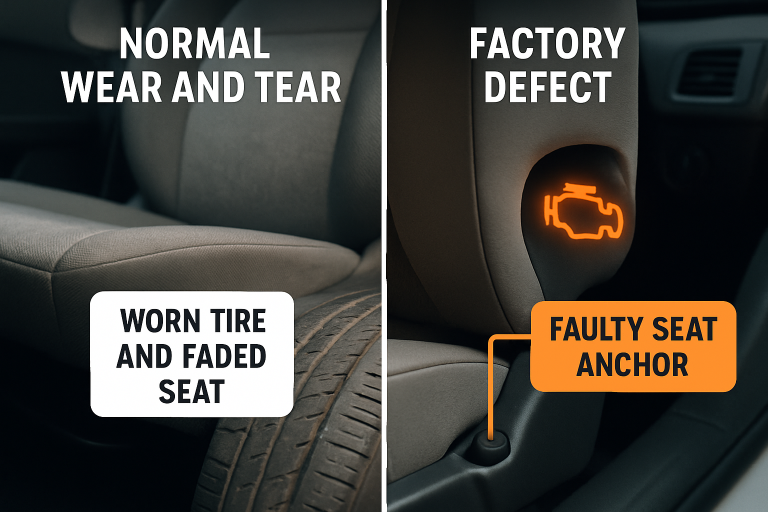Introduction
When your vehicle develops trouble—be it a strange noise, warning light, or handling issue—it’s crucial to determine the root cause. Many vehicle owners face the challenge of distinguishing whether their issue emerges from a manufacturer’s error or is just an expected result of normal usage. This information can be used to decide on potential remedies, safety, and warranty claims. For instance, owners experiencing Buick Regal problems must discern between qualifying factory defects and simple wear from regular driving to take the appropriate next steps.
Careful evaluation helps drivers avoid unnecessary expenses or missed opportunities for repairs covered under warranty. Understanding these distinctions also highlights when to seek professional assistance, ensuring peace of mind and the continued reliability of your vehicle. Keeping detailed maintenance records and documenting recurring issues can strengthen your case when pursuing warranty coverage. Staying informed about common model-specific problems can also help you anticipate issues before they become serious.
Defining Factory Defects
Factory defects are flaws that originate during the manufacturing or assembly process. These can affect multiple vital aspects, including engine performance, crucial safety systems, and sometimes even cosmetic finishes. Manufacturers generally offer warranties that specifically cover such defects, and severe cases may result in wide-reaching recalls. A notable example is the recall involving over 700,000 Chevrolet and GMC SUVs, where faulty child seat anchors due to excessive powder coating made safe installation nearly impossible. These are classic cases of manufacturing oversights with far-reaching safety implications. Identifying these defects early can prevent accidents and reduce long-term repair costs. Vehicle owners should stay updated on recall notices and technical service bulletins relevant to their make and model.
Understanding Normal Wear and Tear
Unlike manufacturing errors, normal wear and tear refers to the predictable gradual deterioration of vehicle components through everyday use. This encompasses everything from thinning brake pads and worn-out tires to faded seat fabrics. These issues are the automotive equivalent of shoes wearing down or paint slowly fading on a home’s exterior. Scheduled maintenance is designed to manage these natural losses and is considered an ongoing responsibility of the vehicle owner, not the manufacturer or dealer. For example, it’s standard for brakes to require replacement after a certain number of miles, regardless of make or model.
Key Differences Between Factory Defects and Wear and Tear
- Origin: Factory defects result from errors during production, while wear and tear develop as a normal part of a car’s lifecycle due to use.
- Coverage: Factory defects should be covered under manufacturer or dealer warranties and may prompt recalls. Wear and tear is nearly always excluded from warranty coverage and is the owner’s responsibility.
- Detection: Defects from the factory often appear early, sometimes right after purchase. In contrast, wear and tear build up gradually, sometimes in predictable patterns based on mileage and conditions.

Implications for Vehicle Owners
Discerning the nature of your vehicle problem can profoundly affect your financial and legal options. If a problem can be traced to a factory defect, you may be eligible for free repairs, part replacements, or even a refund under various lemon laws. Conversely, problems attributed to wear and tear, such as worn-out tires or routine brake replacements, are maintenance items that vehicle owners must plan and budget for. Being proactive and informed helps drivers seek the right support without wasting time or resources chasing the wrong remedies.
Legal Protections and Lemon Laws
Lemon laws serve as consumer protection statutes, shielding you from the financial burden and danger of substantial factory defects. Said laws generally stipulate that for a vehicle to be considered a lemon, a defect must significantly impede its use, value, or safety, and must persist despite reasonable attempts at repair. Lemon laws do not cover owner neglect or ordinary wear and tear issues. For instance, California’s Lemon Law excludes claims resulting from a lack of reasonable care or routine maintenance.
Preventive Measures and Maintenance Tips
Routine maintenance is the most effective strategy to limit the effects of wear and tear and preserve your vehicle’s longevity. Smart ownership practices include:
- Adhering rigidly to the schedule outlined in your owner’s manual for oil changes, filter replacements, and fluid checks.
- Driving smoothly and avoiding aggressive maneuvers that accelerate component wear.
- Tire, brake, light, and fluid levels are inspected to spot small issues before they escalate.
- Consult a qualified mechanic to address any dashboard warning lights or unusual sounds promptly.
Handling small problems before they balloon into major repairs extends your car’s life and maximizes its resale value over time.
Conclusion
The ability to distinguish between factory defects and normal wear and tear equips vehicle owners to make wise, cost-effective decisions about maintenance, warranty claims, and legal rights. Staying vigilant, following a disciplined maintenance schedule, and promptly seeking support at the signs of trouble protect both your investment and your safety. Use the knowledge you’ve gained to ensure your car remains dependable, and don’t hesitate to research ongoing issues—especially for models with known concerns such as the Buick Regal—so you’re always a step ahead.








